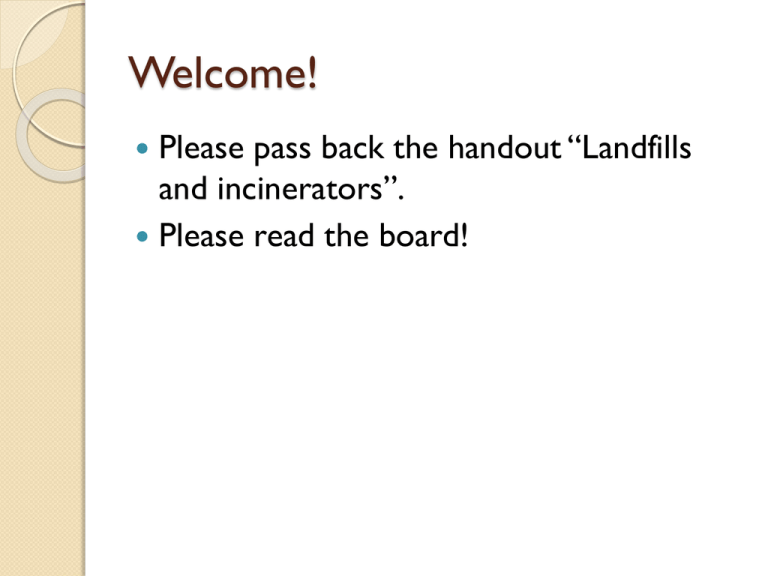Notes: Landfills and Incinerators
advertisement

Welcome! Please pass back the handout “Landfills and incinerators”. Please read the board! TRASH TALK (DID I EVER TELL YOU I REALLY LIKE YO MAMMA JOKES?) Fresh Kills Landfill NY Can be seen from space! NY landfill 19482001 At peak operation, 29,000 tons daily, 10 million tons/yr. That’s a major pile of junk! Landfills in Tejas About 2,000 in US 678 in Texas 21 operating in Harris county Average Texas landfill: 172 acres 28 ft below surface 43 ft above surface That’s a lot of habitat! Oake Landfill Houston Largest landfill in Texas “Sanitary Landfill”? Modern Landfill design: Developed on military bases during WWII as concentrated groups created lots of waste. Move to mechanized system. Looking at the diagram, what possible environmental damage could be caused? 1. Leachate = liquid collected at bottom of landfill Acetone Benzene Lead & other heavy metals Chlorides Liners – plastic, clay Collection and treatment 2. Methane collection Municipal solid waste is covered and compacted daily = no O2 Anaerobic respiration produces methane When decomposers decompose, they’re doing cellular respiration! Material is compacted daily Organic materials in a landfill do not decompose at normal rates Prof. Rathje – The Garbage Project at University of Arizona Archaeological study of landfills from 1973 to 2005 21 landfills, 2 million + items, 15,000 household Calendar dated 1976 dug up in 1988 – how long was it in there? Landfill in San Francisco Did this decompose? Methane collection Methane recovered through pipes Oake landfill methane sent to Budweiser plant to burn for electricity. About ½ of methane leaks into atmosphere Smart companies use methane as a resource Methane has 25x more greenhouse warming potential than CO2 3. Clay cap seals landfill Reclaimed landfills can be used as: Parks Golf courses Ski areas Wind farm/solar arrays Wildlife habitat BUT NOT: homes, lakes, farmland Monitoring required for 30 yrs after closure What about incineration? Haverhill Resource Recovery Facility 1,650 tons-per-day of solid waste 40 megawatts of renewable energy sold wholesale on New England's power grid. Location: 100 Recovery Way, Haverhill, Massachusetts Pros? Cons? Eastern Garbage Patch Floats between Hawaii and California Twice as big as Texas Can be 30 m deep The Trouble with Plastics in the Oceans don’t biodegrade like other debris break down over time into smaller and smaller pieces while still maintaining their chemical make-up As the pieces get smaller fish, mammals, birds and even plankton will consume the pieces which are not digestible While the plastics may not be visible to the eye, studies have shown that in some areas the concentration of plastics outnumbers the concentration of plankton by a ratio of 7:1 This Laysan Albatross chick has been accidentally fed plastic by its parents and died as a result. So what are our options? The “hierarchy” of waste management Reduce (design products to be durable) Reuse (find a different use before disposal) Recycle (break down and reprocess) Incinerate Landfill






